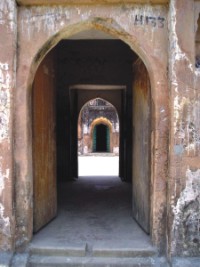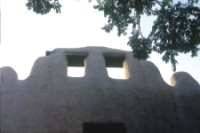| Photography
“Doors and Windows”
Rezwan Ali
 The presence of doors and windows, or in essence, entrances and exits, is ubiquitous in all human societies from the megalopolises of today's world to prehistoric man's cave dwellings. They are found in every place human beings live; in the soaring skyscrapers of the modern world, remote village huts, shantytowns, middle class houses or condominiums, ancient archaeological excavation sites, in the mazes of public gathering spots and our mediums of transport such as automobiles, airliners and trains. The presence of doors and windows, or in essence, entrances and exits, is ubiquitous in all human societies from the megalopolises of today's world to prehistoric man's cave dwellings. They are found in every place human beings live; in the soaring skyscrapers of the modern world, remote village huts, shantytowns, middle class houses or condominiums, ancient archaeological excavation sites, in the mazes of public gathering spots and our mediums of transport such as automobiles, airliners and trains.
We spend our entire lives surrounded by these conduits between the indoor and outdoor, but very few give so much as a moment's thought to the meaning and purpose -- literal or symbolic -- behind what most people consider ephemera. For the most part, we take these passages which provide a link between different worlds for granted.
Torsten Oertel, the director of the Goethe-Institut in Dhaka, along with the help of his colleagues Shameem Rasheed and Khademul Insan, also a photographer, organised the exhibition. Upon first hearing news of an exhibition of photographs of, “doors and windows,” one might ask where the significance in such an exhibit lies. Upon entering the exhibition one realises that Oertel has captured images based upon a single theme without intending to make a specific artistic statement, but rather, leaving the viewer to make subjective value judgements. The collection of photographs was taken over the course of the past twenty-two years during Oertel's travels. The photographs included in the exhibition were selected by Rasheed and Insan. Mumtaz, another Goethe-Institut employee handled the logistics and installation of the exhibit. The work was presented in a playful manner, “like going through the passages as a journey,” according to Oertel who feels, “the most interesting part of the process was deciding how to assemble [the photos].” There are photographs from various countries, including Bangladesh, Germany, Ukraine, Nepal, China, Corsica, USA, Cambodia and Belgium.
 The photographs presented in the, “Doors and Windows,” exhibit are titled with the name of the location where they were taken. Almost fifty photographs are on display in the gallery. Many of the photographs were fairly traditionalist in style, but others required close examination in order to determine what exactly was photographed. The photographs presented in the, “Doors and Windows,” exhibit are titled with the name of the location where they were taken. Almost fifty photographs are on display in the gallery. Many of the photographs were fairly traditionalist in style, but others required close examination in order to determine what exactly was photographed.
Brussels, Belgium; this photo was taken from the inside of a small room with a welcoming atmosphere. In the rear is a large window which opens to a small garden area giving a sense of oneness between the outdoor and indoor environment.
Siam Reap, Cambodia; this is a macro-photography shot of a grated window with slivers of sunlight veiled by seemingly burlap cloth. Initially the viewer finds it hard to discern exactly what is in the photograph giving it a very different feel from the other photographs in the exhibition.
Santa Fe, USA; this is a photograph of the top of a stucco wall with two gaps to let beams of light through. At first glance it appears that it may be one of the many ancient stucco structures which is the traditional building style in the southwest United States. Ironically, this wall was actually a newly built gate to an Indian restaurant in the American desert.
Marienstatt, Germany; here is a photograph of a school which Oertel attended. The shot is taken from a low angle, giving the building an almost imposing look. The window in the photo cannot be seen through, suggesting a separation of the inside and outside, giving the building a regal look.
 Algajola, Corsica; here is a photograph of a small rectangular building with a large blue curtain-like veil in front. The photo has an air of mystery as the viewer can only speculate what lies behind the vibrantly coloured cloth partition. Algajola, Corsica; here is a photograph of a small rectangular building with a large blue curtain-like veil in front. The photo has an air of mystery as the viewer can only speculate what lies behind the vibrantly coloured cloth partition.
“Every culture or society has doors and windows, for purposes of entry, exit, letting in light and general well being, but they are designed quite differently,” Oertel notes. Coming from a rural background, the son of a farmer, he talks about how in his hometown going to see an art exhibition would be considered a frivolous activity. He stressess that he is not a professional photographer without any formal training, and thus is more apt to appreciate the work of untrained artists as it has a more organic, natural feel to him.
“Art is often overly intellectualised. Arts are a form of expression and free thinking and formal training is unneeded,” according to Oertel. He is firm in his stance that arts and culture cannot be limited to people with traditional training, mentioning the actresses Grace Kelly and Sophia Loren who had no formal training, “by focusing closely much is lost.” Oertel comments adding, “with age the ability to perceive objectively decreases for most people. Art cannot be taught, it comes naturally, from within.” In contrast he says people in other fields such as doctors and lawyers require formal training before their work is considered credible.
Oertel also mentions the effects of the digital era upon the arts “The Internet has allowed anybody to distribute and so the standard of quality has gone down. People stay home these days, consumed by their gadgetry.” He criticised the current system, saying, “expense has come to mean quality.”
The “Doors and Windows,” exhibition of Torsten Oertel's photography will be on exhibition through the 29th of May. The gallery is open for viewing on weekdays from 2:00pm 8:00pm.
Copyright
(R) thedailystar.net 2008 |
|
